by Melanie Taylor | Dec 14, 2018

Aim to find JOY in this holiday season.
As the holiday season quickly approaches, many people are filled with extra holiday cheer and enthusiasm. Some are jolly but still overwhelmed with all of the activities, decorating, and shopping that needs to be completed. Then, there are those that find the holiday season as a reminder of things such as the death of a loved one, family feuds, divorce…the list goes on. If you are feeling this way, here are a few tips to make getting through the season a little bit easier.
- Feel your emotions – Many people want to suppress their sadness or anxiety, but this only makes it worse. We are all allowed to grieve, cry and feel mad at times. If you feel this way, let yourself feel your feelings. You will feel better once you have accepted and worked through the emotions. You also do not have to force yourself to feel happy just because it is the holiday season.
- Reach out to others – Instead of secluding yourself, spend time with others whether it’s at church, a community group or with family and friends. Spending time with others and socializing is good for the spirit.
- Volunteer – There are tons of volunteer opportunities during the holidays. Try something new and volunteer your time to a worthy cause. You’ll feel great about helping others and contributing to a cause.A national survey commissioned by UnitedHealth Group talked to 3,351 adults and found the majority of participants reported feeling mentally and physically healthier after a volunteer experience.
The research showed:
* 96% reported volunteering enriched their sense of purpose in life
* 94% of people said volunteering improved their mood
* 80% of them feel like they have control over their health
* 78% of them said volunteering lowered their stress levels
* 76% of people said volunteering has made them feel healthier
* About a quarter reported their volunteer work helped them manage a chronic illness by keeping them
active and taking their minds off of their own problems
* Volunteering improved their mood and self-esteem
- Be realistic – Realize that times and traditions change as families grow and age. Do not focus on things having to be the same every year. Be willing to accept changes, such as adult children may not be able to attend the family gathering, so utilize technology and talk through video conferencing, share pictures on email and/or Facebook. Find a way to make it work.
- Set aside differences for everyone’s sake. Aim to accept family and friends the way they are, even if they do not meet your expectations. Leave grievances at the door for the day and enjoy your family and friends. Share those grievances and talk at a more appropriate and private time. Also, remember they could be feeling the stress of the holiday too. So, be patient if someone is grouchy or sad as you celebrate. You may both be feeling the same way.
- Learn to say no – Be realistic in the number of activities you and your family can participate. Do not feel guilty because you cannot attend every party and event you are invited too. Graciously decline an invite and share that your schedule is booked, but thank them for thinking of you. A host does not expect that everyone will attend their parties.
- Take a breather as needed – If you start to feel overwhelmed with anxiety, anger or sadness take a few minutes to be alone. Take 15 minutes to spend in the quiet to reduce the stress and clear your mind. For example: listen to soothing music, do a few mindful breathing exercises to slow yourself down or read a book to temporarily escape the stress.
- Seek professional help as needed – there are times when the emotions are just too overwhelming to sort through on our own. If you continue to feel sad, anxious, angry, etc. there is absolutely no shame in seeking the help of a doctor or mental health professional. It will only help you work through your feelings with a non-bias person. Helping yourself feel better will improve your quality of life and those around you.
Learn to take care of yourself first. Learn your limitations and accept them. Don’t t let other’s expectations overwhelm you. Just remember when you start feeling extreme levels of emotions and/or stress, take a few deep breathes and remind yourself to relax and feel the moment. Be mindful of your surroundings and remind yourself of your many blessings even when going through difficult times. Make it your personal goal to feel your feelings and enjoy what you can about the holiday season whether it is the twinkling lights, time with friends and family, the food or any of the many special holiday traditions.
Striving for and maintaining a healthy lifestyle is an achievable goal and a National 4-H Council mission mandate for all of our 4-H members, families and volunteers. To learn more about healthy lifestyles and 4-H, find your local UF/IFAS Extension office.
Sources:
by Allison Leo | Nov 9, 2018
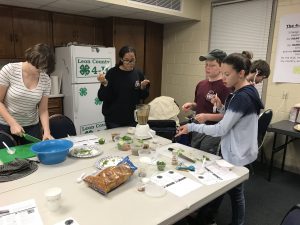
Youth making blender salsa during Leon County’s 4-H Culinary Camp
Are you having a tough time finding kid-approved snacks? With a little extra planning, you can add extra fruits, vegetables and whole grains to your child’s diet. The following snacks can be included in lunch, enjoyed as an after school snacks or as a great addition to any 4-H club meeting!
Stovetop Popcorn
It’s quick, easy, delicious AND a whole grain. Stove top popcorn is delicious just with a sprinkle of salt, but kids can get creative by adding toppings like sugar/cinnamon, Parmesan cheese or lemon zest with pepper. The United States Department of Agriculture (USDA) recommends making half of your grains whole grains each day. Here’s a simple stovetop popcorn recipe for you to try.
Snack Mix
This is another great way to get kids involved in creating their own snack mix using a variety of items. The key is to change it up every few weeks to keep kids interested. Suggested items include: chex mix, dried blueberries, raisins, chocolate chips, walnuts, pretzels, whole grain crackers, popcorn, and more. Use this snack mix recipe as inspiration.
Fruit or Vegetable Kebabs
Kids can help put together this great afterschool snack. For fruit kebabs, try grapes, apples, blueberries or kiwi. For vegetable kebabs, try green peppers, mushrooms, tomatoes or yellow squash. They can be simple with only two items such as strawberry and pineapple or cherry tomatoes and broccoli. You can dip the fruit kebabs in vanilla yogurt or drizzle them with honey. A side of ranch or hummus pairs perfectly with vegetable kebabs. The key is to purchase fruits and vegetables that are in-season to make this snack budget friendly. Here is a resource to find out what is in season in Florida.
Hummus
Let’s be honest, hummus and vegetables might not be at the top of the list of your kid’s favorite snack item. The key is to allow kids to make the hummus and serve it with a variety of items to dip. You can dip carrots, celery, radishes, pretzels, or crackers in hummus. Hummus can be made ahead and stored for a few days sealed tight in the fridge. Here is my favorite hummus recipe.
Blender Salsa
Here’s another fun way to get kids in the kitchen to make a perfect snack for after school. You can put together this recipe in less than 5 minutes – it’s so easy Try this basic blender salsa recipe, but feel free to add your own inspiration by adding extra ingredients.
Smoothies
Endless recipes make smoothies a great after school snack. You can even pack a smoothie for lunch. To ensure the smoothie stays nice and cold, place the thermos in the freezer the night before. In the morning, pour the freshly made smoothie into the frozen thermos. A personal favorite smoothie of mine is: 1 frozen banana, 1 cup milk, 1 scoop of peanut butter, 1 small scoop of cocoa powder and a handful of spinach. The spinach blends right in (you can’t even taste it), and the cocoa powder hides the color of the spinach.
Whole Grain Muffins
Whole grain muffins are an easy snack to make ahead and enjoy throughout the week. Muffins freeze well and still taste delicious when thawed. You can make chocolate chip, strawberry, blueberry, banana, pumpkin and more. Muffins can also be used as a quick breakfast while you are running out the door. For some extra protein, just add some nut butter, such as peanut or almond. Here is a delicious whole grain blueberry muffin recipe.
To learn more about 4-H’s healthy living goal, find your local UF/IFAS Extension office.
by Niki Crawson | Oct 26, 2018
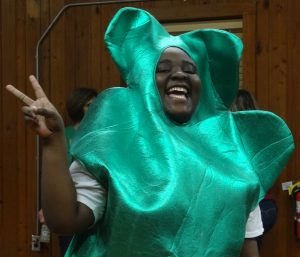
A happy 4-H member’s smile is contagious in this face-friendly clover costume.
While Walmart has already jumped to Christmas season, many parents are still scrambling to figure out their children’s costume for October’s Halloween party. Now, all of us have the cutest pumpkins in the pumpkin patch, but none of our children want to dress up as pumpkins anymore! Gone are the simple days of our generation when white sheets with eye holes were the extent of our Halloween attire.
With the hectic schedule of the world and the complicated costumes of today, here are a few guidelines to follow when helping children choose Halloween costumes (and keep them safe safety during the spooktacular holiday season).

This little pumpkin has comfortable walking shoes for trick or treating.
If it Fits, it Flies Past Inspection
While cute or scary may be what the children are striving for, well-fitting costumes should be the goal for all parents. Ill-fighting costumes are a disaster waiting to happen. Costumes that hang loosely become a distraction. Capes, gowns, or any material in length that drags the ground can be a tricky thing to maneuver at any age so be sure to trim above the ankle. Speaking of ankles, shoes that are too high can cause unexpected hospital visits so keep shoes low to the ground and comfortable to walk in. Children (and parents) do a lot of walking to collect their candy treats. Shoes that are too large or too small can cause blisters and cranky children, all things to avoid on a fun night.
Can You See Me Now?
One of the scariest things about Halloween is not what you can see but what you can’t see! Not being able to see children in costume in poorly lit areas of the neighborhood can be scary for adults. Parents, remedy this by using inexpensive reflective paint or tape to make children’s costumes visible or giving them glowsticks to wear or flashlights to hold.
Be sure to think about if your children can see well in their costumes. Masks can be difficult to wear if they don’t fit well. Be sure that eye and breathing holes are extra-large. If a costume can be complete without a mask, consider skipping it and use makeup. If costumes are come with hats, scarves, or capes, secure them down with velcro to keep from hitting others.
Does my Makeup Look OK?
Children love face paint and makeup, and hair dye appears to be the latest trend. Halloween seems a good fit for these outlets, but use them with caution. More and more children are sensitive to pigments found in everyday items – makeup included. Your children may be going for the spooky look but not at the risk of it being itchy and painful. If your children will be using face paint, makeup and/or hair dye, do a simple test run at least a week before use to ensure there are no allergies to the ingredients.
Accessorize Everything…Or Not

Makeup that does not obstruct children’s view is essential to their safety.
You’ve probably heard that “accessories make the outfit,” but in the case of Halloween and children, accessories can be highly overrated. Parents usually end up carrying the accessories that went with their children’s costumes before the night is over. But if children insist their outfits are not complete without a Ninja sword or Katniss Everdeen’s bow and arrow, be sure they are easily distinguished toys. Those accessories should be soft and flexible.
Spooktacular Adventure Awaits!
Whether you get into Halloween with costumes or not, these tips are good reminders for all of us to look out for children and keep them safe. Enjoy the upcoming holiday seasons!
To find out more information about 4-H programs that can offer essential life skills to your children or to volunteer your time to work with children in your area, please contact your local UF/IFAS County Extension Office, or visit http://florida4h.org.
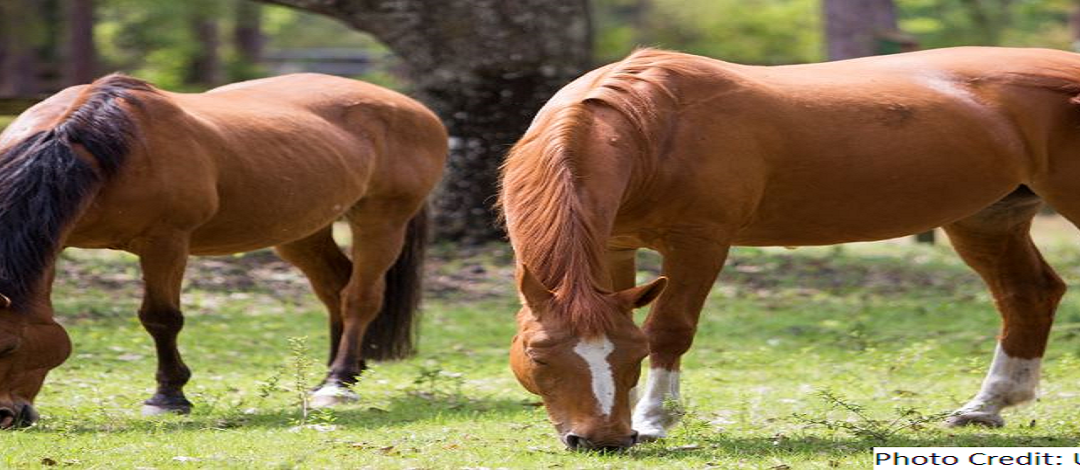
by amgranger | Sep 28, 2018
Be Prepared and Have a Plan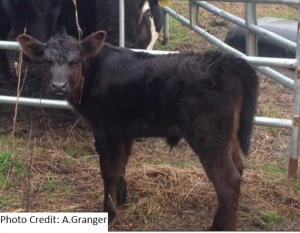
This time last year, we were helping our 4-H friends all over Florida recover from Hurricane Irma. Hurricane season has been quiet in Florida so far, but that doesn’t mean we need to let our guard down – we still have two more months of hurricane season.
So,what would you do if you didn’t have electricity? How will you care for your 4-H project animals? Do you have an evacuation plan? Answers to these questions become major issues when dealing with disasters.
Disasters can be natural/weather-related, man-made or accidental. Regardless of the type, it’s important to be prepared and have a plan for you and your animals.
Plan for Your Animal’s Safety
Whether you evacuate or shelter in place, here are a few considerations:
- Be ready to leave once the evacuation is ordered.
- Evacuate animals as soon as possible.
- Your project animal won’t be able to stay with you in a shelter like a dog or a can.
- Know where safe livestock facilities are in your area or along your evacuation route.
- If you can’t evacuate, decide if you’re keeping animals confined to a barn or turning them out into pastures.
- Barn confinement may become dangerous and take away the animal’s ability to protect themselves.
- Pastures should be at least one acre in size with no potential hazards (barbed wire, power-lines, polls or items that can be picked up by the wind).
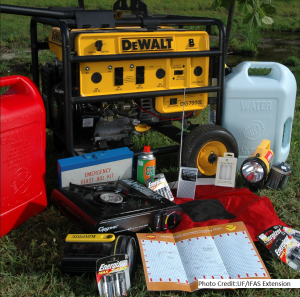 Disaster Preparedness for Livestock – Why Livestock Owners Need to Be Prepared
Disaster Preparedness for Livestock – Why Livestock Owners Need to Be Prepared
The Florida Department of Agriculture and Consumer Services (FDACS) has some suggested guidelines about preparing livestock and horses for disasters:
- Check with your local humane organization, extension office or local emergency management agency to read about your county disaster response plans.
- Determine safe evacuation routes for trailers and livestock.
- Prepare a Farm Disaster Kit and Basic First-Aid Kit. Remember, supplies during or after the disaster may be in short supply, or roadways may be blocked. Keep kits up-to-date, keep them on-site and in your vehicle.
- A vaccination and test records (Coggins, health certificates, etc.)
- A list of all animals, where they are located on the farm and feeding instructions/records
- Sanitation items, cell phone, flashlights, portable radios and batteries.
- Have feed, water, handling equipment, tools, veterinary supplies and a generator (with fuel) on hand if possible.
- Make a list of emergency numbers – veterinarian, neighbors, state veterinarian, animal shelter, county extension office,local volunteer organizations and someone outside of the disaster area.
- Make sure you have proof of animal ownership. Have temporary ID supplies on hand like permanent markers and plastic bands that are safe, durable and visible. ID should include your name, address, and telephone number.
- Poultry need access to high areas to perch if you’re in an area susceptible to flooding. Provide access to clean water and food.
- Remove barbed wire or other fencing so animals can move to areas of safety during flooding or high winds.
- Store water in large containers (enough for a week) suck as troughs, swimming pools or boats
- Secure items that might be picked up and thrown by the wind like pieces of metal, troughs, tanks or trailers.
- Ensure there is safe shelter, fencing or pens.
- Keep animals in groups they’re used to where they are securely contained and protected from the elements.
Resources:
For more information about 4-H, contact your local UF/IFAS County Extension Office. If you are an adult or teen with skills or knowledge you’d like to share, ask about becoming a 4-H volunteer!
by Allison Leo | Aug 24, 2018
 Cooking with Florida Produce
Cooking with Florida Produce
Knowing how to cook and being comfortable in the kitchen is an important life skill that has enduring benefits. Leon County 4-H hosted a culinary day camp with a unique twist: educating youth about Florida produce and local agriculture. In addition to teaching culinary techniques and nutrition, youth learned foundational cooking skills and took things a step further by building connections between local farms and their kitchens.
Teaming up with Fresh from Florida Kids
Chef Paula Kendrick co-led the camp. featuring Florida-grown produce. The importance of nutrition and incorporating healthy foods into the diet was an ongoing theme during the camp. Lessons on how to read food labels, the importance of whole grain and limiting sugar intake were also featured. A salsa cooking competition using local products ended the camp. Chef Paula is from Florida Department of Agriculture and Consumer Services – Fresh from Florida Kids.
Local Farm Highlighted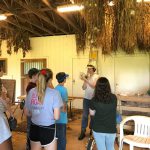
A visit to Full Earth Farm in Quincy helped youth see how a small local farm operates. Owners Katie Harris and Aaron Suko warmly welcomed the group to their farm and gave them a tour. Florida seasonality, composting benefits and how local farms provide fresh produce to businesses and homes in our area were tour highlights. The group left with a box of fresh summer squash to deliver to their next stop – Damfino’s Cafe and Market. Damfino’s sources local products for their menu items. Owner Lucy and Chef Max spoke to the group about their restaurant’s mission of connecting the local community to local farmers.
During the camp, youth were eager to try all the recipes and many of the campers tried new food items for the first time. Fresh herbs from the 4-H garden were used in a number of the recipes. Rosemary was added to honeydew sorbet, and basil was added to sautéed summer squash.
 Healthy Eating is Best Learned in the Kitchen
Healthy Eating is Best Learned in the Kitchen
Chef Paula Kendrick shared, “The students got to visit a Florida farm, eat at a local Florida farm to table restaurant and learn how to handle and cook fresh Florida produce. I love helping them to make that farm to table connection while teaching them about Florida agriculture. Cooking is one of the best ways to actually get them to try new things and to understand the importance of healthy eating and nutrition.”
For more information on healthy living 4-H projects such as cooking, contact your local UF/IFAS County Extension Office.
by aschortinghouse | Jul 27, 2018
GAGA BALL
If your youth has attended 4-H Camp Timpoochee or Cherry Lake with the UF/IFAS 4-H Camping Program, they’ve had the chance to play GaGa Ball. You’re probably wondering what kind of name is GaGa ball. It’s not just a made-up name. GaGa ball has a rich history. GaGa is translated from Hebrew as “touch-touch”. It’s said to have originated in Israel, and it has become a popular game at camps around the United States. GaGa Ball is a version of dodgeball and is just as fun.
LET’S PLAY!
GaGa ball is not only fun to say, but it is really easy to learn. First, you need a place to play. GaGa ball is played in a GaGa pit. Here’s just one of many articles on how to build your own GaGa Ball Pit. Next, you need a ball. GaGa balls are not specific, although a heavy duty dodgeball is recommended. The rules of the game vary place to place, but we play by the following rules at 4-H Camp:
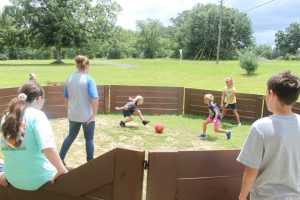
- You hit the ball with your hands only.
- If the ball hits you below the knee, you are out.
- If the ball bounces of the wall and hits you below the knee, you’re out.
- If you hit the ball out of the pit, you’re out.
- If you hit someone in the face, you’re out
- If the game is going slowly, the leader can call “Hands-In”.
Hands in means everyone who is already out can put their hands over the wall of the pit and try to get those still in the pit out.
Rules can be made and altered to fit the group that is playing the game although the first two rules are staples of the game.
WHAT’S THE BIG DEAL?
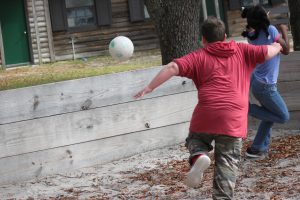
GaGa ball is a great way to expend extra energy during day camps, but it also is a great way to build and practice life skills. First off, youth are put in situations in every game where they have to practice decision making, discipline, resiliency and many other life skills 4-H strives to instill in our youth. Of course they have to practice their conflict resolution skills as there will inevitably conflicts that arise from their competitive natures. Most importantly, playing GaGa ball helps kids practice a healthy lifestyle. GaGa ball teaches many important lessons, and is a bunch of fun. So when you hear someone say, “Let’s play GaGa ball!”, give it a try and embrace the challenge.
Learn more about the history of GaGa Ball













